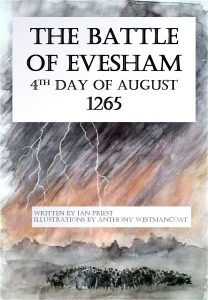Pilgrimage is the most essential of medieval studies – that’s a conclusion which Tim Porter has drawn from years of reading, research and exploration. Religion, politics, economics, travel, industry, art, architecture – pilgrimage opens into all these fields, and many more! And it cuts across classes and genders like nothing else, because nobody could be denied the vocation, if it was held to be genuine. Scores of places had some kind of pilgrimage attached to them: but the Gloucestershire/Worcestershire region was especially rich, with a host of saints and shrines reflecting every aspect of the ethos. Hailes and Winchcombe in particular offer in a nutshell so much of what we need to know.
£7.50

William de Nangis’ account of the Battle of Evesham is an important source predating some of the other chronicler accounts. Although some sentences and the paragraph describing the death of Simon de Montfort have been translated, for example by John Nichols in his History and Antiquities of the County of Leicester, the whole passage has not previously been translated.

The fate of the remains of Simon de Montfort, earl of Leicester, has long been a mystery. Since his death at the battle of Evesham in 1265, one foot of the dismembered corpse has been confidently traced to Alnwick abbey in Northumberland, from where it disappeared, probably at the Reformation. A skull displayed in the Almonry Museum and Heritage Centre at Evesham may belong to a member of the Montfort family. Stories abound, of secret tunnels under the River Avon, and of remains collected by Montfort’s widow and interred in St Mary’s abbey, Kenilworth. In this booklet Dr Cox reviews the evidence for an alternative last resting place of Earl Simon’s bones, and outlines the circumstances under which they might be recovered and identified. A challenge thus awaits us to provide for Simon de Montfort the discovery and preservation accorded to the last Plantagenet king of England, Richard III.

What happened to Simon de Montfort, leader of the Reformers, after his defeat at the Battle of Evesham? Was Earl Simon captured alive and later murdered? Does this explain the murder of Henry of Almain by Simon’s sons, Simon and Guy? Could such behaviour be reconciled with prevailing views on chivalry? The questions raised by the Templar’s account will be discussed for many years.


Written by Ian Priest and with illustrations and additional material by Tony Westmancoat is an introduction to the Battle of Evesham for younger readers, with illustrations to colour. Ian and Tony are members of Circa 1265, a living history and re-enactment group focused on the Second Baronial Revolt and the Battle of Evesham.

1275… a cry for help from a woman who is kidnapped at sea. Present day. Dutch archivist Fenna van Wijk is helping architect Ned Thompson to sift through a stack of ancient papers kept in an untouched archive in an old English manor house in Lincolnshire. Among manuscripts dealing with the holy Gilbert of Sempringham, they discover a letter from 1275, written by Eleanor de Montfort, the young bride to be of Welsh prince Llywelyn ap Gruffudd. During their research, Fenna stumbles upon a mysterious child: Gwenllian. The English king Edward I had this infant locked away for ever in a cloister in … Sempringham. When Fenna and Ned try to understand this harsh decision, they find more than they bargained for.
“Gwenllian” is our first move into serious historical fiction.

A new account of the death of Simon de Montfort at the Battle of Evesham, found on a fourteenth-century roll belonging to the College of Arms.
Privacy Policy | Cookie Policy & Settings I Copyright © 2023 The Simon de Montfort Society I Charity number: 1092319 I Website Design: Abbey Gate Media